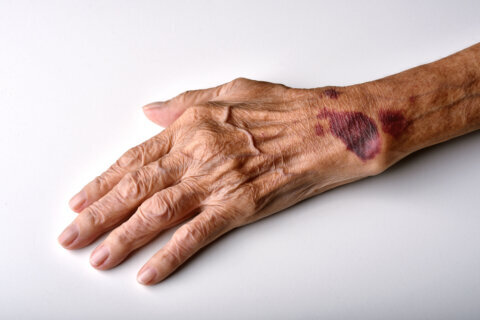This content is sponsored by MedStar Washington Hospital Center.
Osteoarthritis is the most common form of arthritis, and it affects millions of people around the world. While there isn’t a cure for this type of arthritis, there are many treatments that can help relieve pain.
Osteoarthritis is a degenerative disease, which means it worsens over time as a result of regular wear and tear on the joints, in addition to natural changes within the body, said Dr. Benjamin Plotz, a rheumatologist at MedStar Washington Hospital Center.
Age, genetics and obesity can play a role in hand osteoarthritis, as can overuse, prior injuries, race and sex. It is more common for people who are older than 50 to develop hand osteoarthritis, as is the case with Caucasians and people of Asian descent. Women are more likely to develop hand osteoarthritis, possibly because protective effects from estrogen decrease with age, leaving joints more vulnerable to degeneration, Dr. Plotz said.
Hand osteoarthritis is often marked by pain, stiffness, tenderness, loss of flexibility and swelling.
“If you have one or more risk factors and are experiencing pain and poor grip strength in your hands, visit your doctor,” Dr. Plotz said.
Providers will conduct a physical examination, review a patient’s medical history and order an X-ray to confirm that patient has hand osteoarthritis. An X-ray that shows cartilage and bone damage will result in a diagnosis, Dr. Plotz said. Based on what is gathered, a doctor will recommend treatment options to help manage pain.
When it comes to treatment, physical therapy is one of the best ways to minimize pain and maximize function in the hands, Dr. Plotz said.
“We recommend working with a physical therapist who specializes in hand therapy to strengthen the joints. It’s like giving yourself a natural, invisible bandage that provides support, reduces pain, and increases function and range of motion in your hands,” he said.
There are other treatment options available including: braces or orthotics to support the hand, especially the thumb; and non-steroidal anti-inflammatory medications like ibuprofen, or topical diclofenac are regularly employed. In more severe cases, corticosteroid injections or oral tablets to ease pain and swelling are use, or less proven medications such as colchicine, an anti-inflammatory drug that may decrease inflammation and pain in osteoarthritic joints and methotrexate, an immunosuppressive drug that can reduce inflammation and joint damage can sometimes help.
They may also recommend the patient take supplements containing chondroitin, which may help improve function and reduce stiffness and pain, or use topical or oral non-steroidal anti-inflammatories to decrease any pain or swelling.
“Everyone responds differently to treatment,” Dr. Plotz said. “We individualize treatment plans for each patient to ensure prescription medications won’t interfere with treatments or supplements you use for other health conditions.”
Turmeric, a spice that contains curcumin, may be an option in a treatment plan. To incorporate turmeric, take around 500 milligrams up to three times a day via capsule or integrate it into your foods.
“Although much remains to be studied about this supplement, it has been used for centuries in both Ayurvedic and traditional Chinese medicine to treat pain. Several studies have shown it to be safe and effective in relieving arthritic pain,” Dr. Plotz said.
Doctors will also always screen for diseases that increase risk for hand osteoarthritis
There is still a lot to learn about hand osteoarthritis, and researchers are working to know more. These findings will help inform future treatment options, Dr. Plotz added.
Dr. Plotz himself co-authored a review of current research on risk factors for hand osteoarthritis. The findings point to evidence of a link between osteoarthritis and alcohol use, cardiovascular disease, diabetes and hormones from fat cells.
Dr. Plotz encourages all patients to make the most of the treatment options that are available to them, and speak up if they have persistent hand pain.
“Too often patients accept their hand discomfort without mentioning it to their doctor. Untreated hand osteoarthritis can lead to more pain and less function over time,” he said.
Whether you’re using a phone, drinking a cup of coffee, or brushing your teeth, everyday tasks don’t have to be painful! You have options to improve your quality of life. Schedule an appointment with your doctor to find out what will work best for you.
Read more about hand osteoarthritis in a blog post by Dr. Plotz on the MedStar Health website.







